Alaska is the largest state of the United States in area. It is almost a fifth as large as all the rest of the United States, and more than twice the size of Texas, the second largest state. But Alaska has a relatively small population. According to the 2020 census, Alaska ranks 48th among all the states in population. Only Wyoming and Vermont have fewer people than Alaska. Alaska is often called the Last Frontier because much of the state is not fully settled. Juneau is Alaska’s capital. Anchorage is the state’s largest city in terms of population.
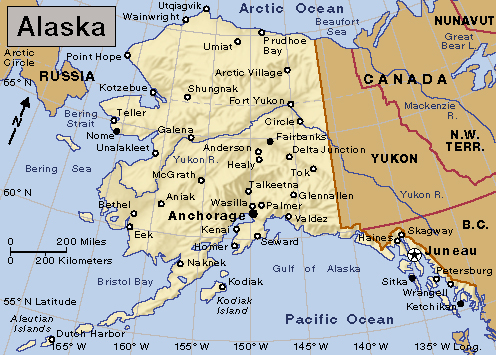
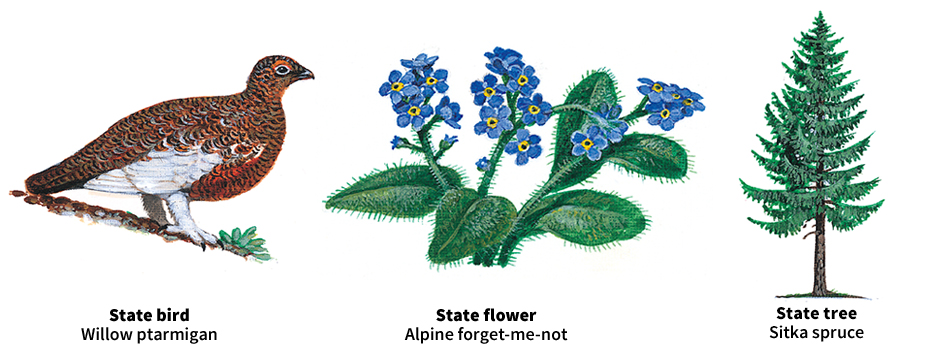
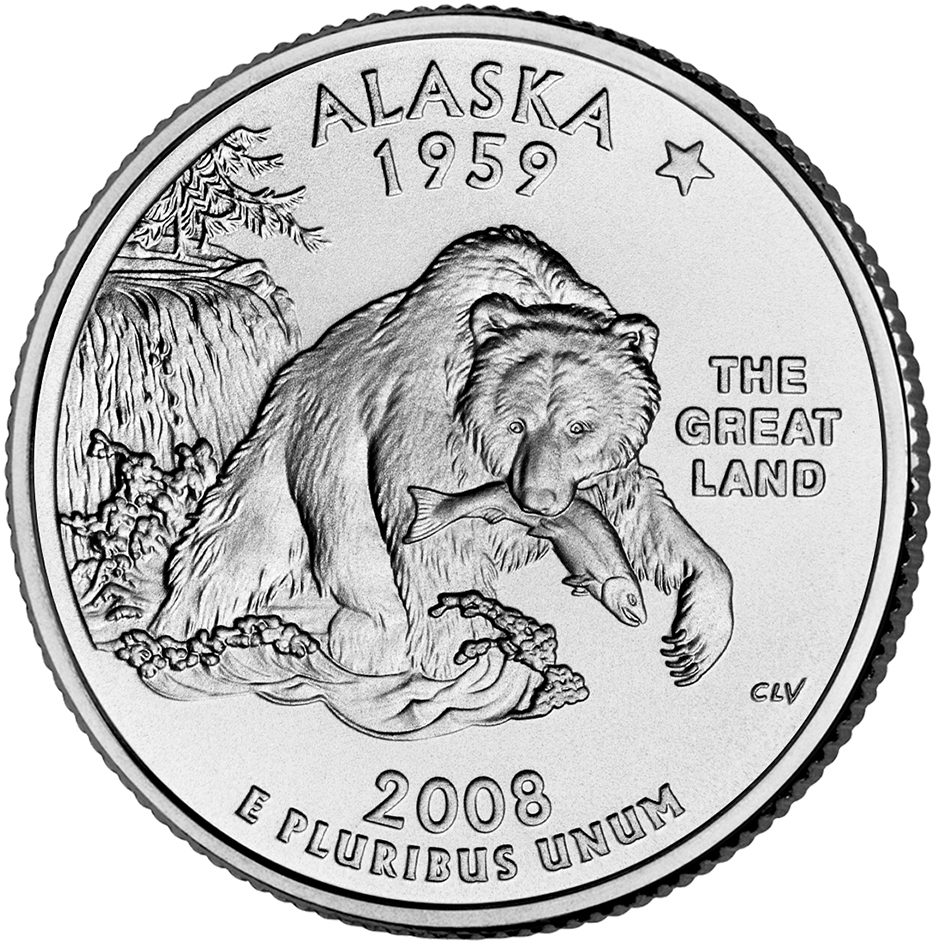
When Alaska entered the Union in 1959, it was the first new state in 47 years. About 500 miles (800 kilometers) of Canadian territory separate Alaska from Washington, the nearest of the other U.S. states. Alaskans often refer to the rest of the continental United States, including Washington, as the “lower 48.” The Alaska Highway, which runs between Delta Junction in Alaska and Dawson Creek in the Canadian province of British Columbia, connects Alaska with the road systems of the other states as well as with Canada.
The Alaskan mainland’s most western point is only 51 miles (82 kilometers) from Russia. Alaska’s Little Diomede Island, in the Bering Strait, is about 21/2 miles (4 kilometers) from Russia’s Big Diomede Island. No other part of North America is closer to Asia.
Almost a third of Alaska lies north of the Arctic Circle. However, Point Barrow, the northernmost point, is almost 1,300 miles (2,090 kilometers) south of the North Pole. The state has a wide range of temperatures—as low as –80 °F (–62 °C), and as high as 100 °F (38 °C). The climate and soil as far north as the Arctic Circle permit farmers to raise livestock and grow barley, potatoes, and other crops. The summer sun shines about 20 hours a day in Alaska, and crops grow rapidly there. At Point Barrow, from May 10 to August 2, the sun never sets.
Alaska is famous for its towering mountains and beautiful scenery. Denali, which rises 20,310 feet (6,190 meters) above sea level, is the nation’s highest peak. In the language of the Indigenous (native) Athabascan people, the name Denali means The Great One or The High One. The mountain was once officially known as Mount McKinley. Alaska also has the 15 next highest peaks and almost all of the active volcanoes in the United States.
Denali rises in central Alaska’s Denali National Park, one of a number of national parks in the state. Wrangell–St. Elias National Park in Alaska is the nation’s largest national park. It covers more than 8 million acres (3 million hectares). Alaska also has the nation’s largest wildlife refuge—the Yukon Delta National Wildlife Refuge, which covers nearly 20 million acres (8 million hectares).
Inuit, Aleuts, and a number of Indigenous North American peoples were living in Alaska when Russian explorers arrived. A Russian trader established the first white settlement, on Kodiak Island, in 1784.
United States Secretary of State William H. Seward bought Alaska from Russia in 1867 for $7,200,000—only about 2 cents per acre (5 cents per hectare). Some Americans thought the region was a wasteland of ice and snow. They called it Seward’s Folly, Seward’s Icebox, and Icebergia. However, Alaska proved to be rich in fish, minerals, timber, and potential water power. The value of resources taken from the region has paid back the purchase price thousands of times. Huge oil reserves at Prudhoe Bay along the Arctic coast rank as Alaska’s chief source of wealth.
People
Population.
The 2020 United States census reported that Alaska had 733,391 people. The population had increased 3 percent over the 2010 figure of 710,231. According to the 2020 census, Alaska ranks 48th in population among the 50 states. Only Wyoming and Vermont have fewer people than Alaska.
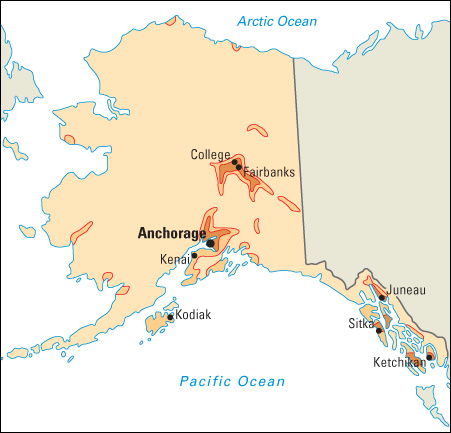
About two-fifths of Alaska’s people were born in Alaska. Many of those who were born in other states are members of the United States armed forces and have been assigned to Alaska. Alaska has about 100,000 natives. Of this figure, about two-thirds are Inuit and one-third are Indigenous North Americans—people once known as Indians. Most Inuit live in the north and west. Many of the Inuit are Aleuts. Aleuts live on the Alaska Peninsula and the Aleutian Islands. Haida, Tlingit, and Tsimshian peoples live in the southeast. Athabascan groups live mainly in Alaska’s interior.
Most of the white population lives in or near Anchorage, Alaska’s largest city; in Fairbanks; and in the southeastern coastal cities. Anchorage and Fairbanks-College are Alaska’s only metropolitan areas (see Metropolitan area).
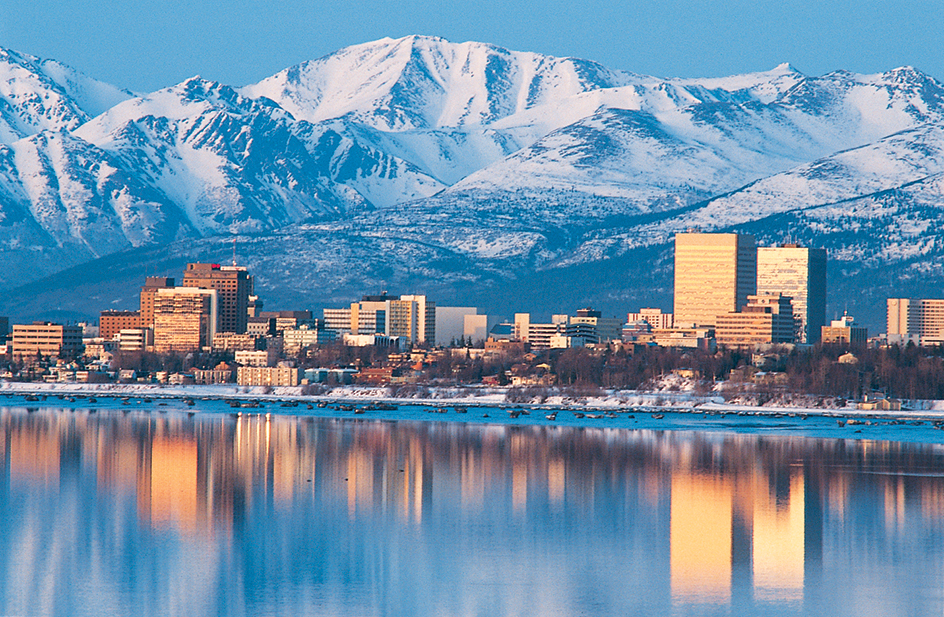
Schools.
The commissioner of education heads Alaska’s education department. The commissioner is appointed by the State Board of Education and Early Development, subject to the governor’s approval. Seven voting members of the board are appointed by the state’s governor. Two nonvoting members, representing students and the military, also sit on the board. The board establishes policies for Alaska’s public school system.
Children in Alaska must attend school from the ages of 7 through 16. Each organized borough is a school district and has a school board. Cities that lie outside the organized boroughs have city school boards. Regional school boards operate schools in rural areas outside the organized boroughs.
Alaska has three schools that grant bachelor’s or advanced degrees and are accredited by the Northwest Commission on Colleges and Universities. The University of Alaska has several campuses throughout the state. The state’s other two colleges and universities are Alaska Pacific University in Anchorage and Ilisagvik College in Barrow.
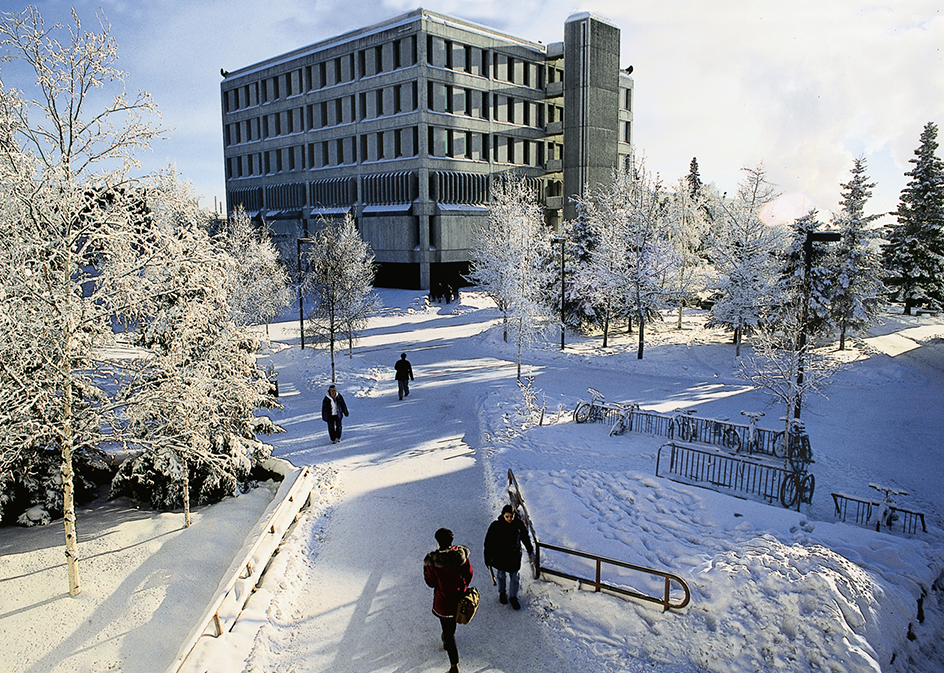
Libraries and museums.
Alaska’s State Library, in Juneau, includes a historical section and a state archives and records management section. Academic libraries are at the University of Alaska Fairbanks, the University of Alaska Anchorage, and the University of Alaska Southeast in Juneau.
The Alaska State Museum in Juneau features exhibits of Inuit and Indigenous, or Native American, objects. It also has displays dealing with animals and minerals in the state. A branch of the state museum, the Sheldon Jackson Museum in Sitka, has collections from the Inuit and other Indigenous Alaskan cultures. The University of Alaska Museum of the North in Fairbanks focuses on the state’s cultural and natural history. Other cities that have museums include Anchorage, Kenai, Ketchikan, Kodiak, Palmer, Skagway, and Wasilla.
Visitor’s guide
Alaska’s vast wilderness attracts many people who love the outdoors. Expert mountain climbers tackle Alaskan peaks that rank as the highest in North America. People fish for record-sized salmon, trout, and halibut.
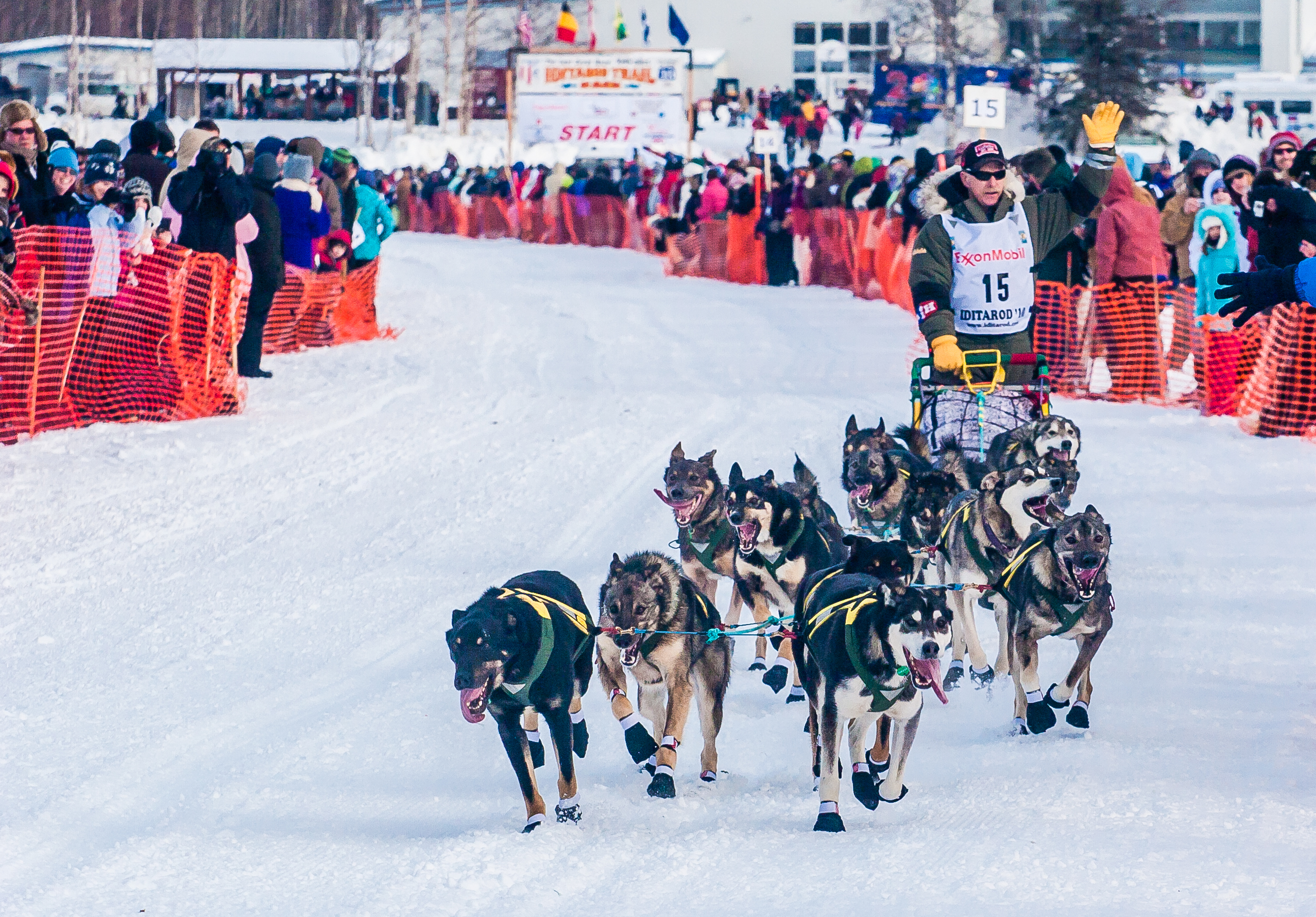
Thousands of tourists come to see Alaska’s magnificent mountain scenery and historic coastal towns. Many vacationers from the “lower 48” drive to the state on the Alaska Highway or take a scenic cruise along the Inside Passage of Alaska’s southeastern coast.
Alaska offers interesting activities for everyone. These activities include whitewater kayaking, bird watching, and photographic tours of the famous “northern lights.”
Perhaps the most popular winter event in Alaska is the Iditarod Trail Sled Dog Race, held in March. Sled drivers called mushers and their teams of dogs race over a rugged course from Anchorage to Nome. The course is about 1,000 miles (1,600 kilometers) long and usually takes about 10 to 17 days to complete.
Land and climate
Land regions.
Alaska has four main land regions: (1) the Pacific Mountain System, (2) the Central Uplands and Lowlands, (3) the Rocky Mountain System, and (4) the Arctic Coastal Plain.

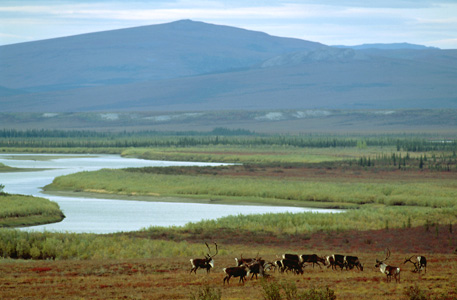
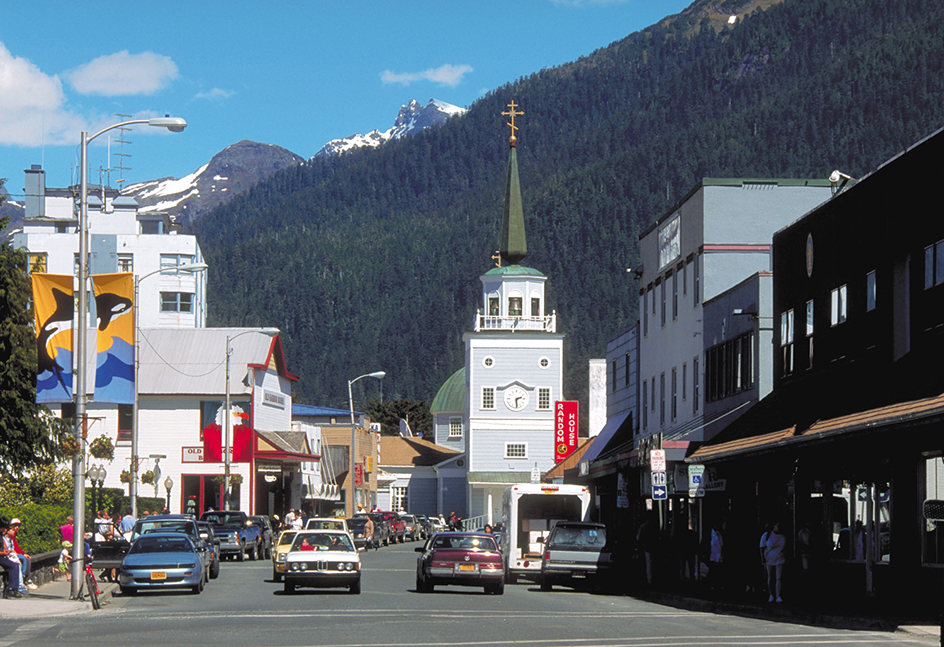


The Pacific Mountain System
of Alaska is part of a group of ranges that extends down the Pacific Coast to southern California. In Alaska, the ranges curve from the Aleutian Islands in the west through south-central Alaska and along the coast in the southeast.
The region has many subdivisions. The strip of coastal land 400 miles (640 kilometers) long in the southeast is called the Alaska Panhandle. It is 10 to 150 miles (16 to 241 kilometers) wide, and includes tall mountains and ice fields. The Saint Elias Range extends northwestward from the Panhandle. Mount Saint Elias rises 18,008 feet (5,489 meters) in this range. The Wrangell Mountains, northwest of the Saint Elias Range, include Mount Bona (16,421 feet, or 5,005 meters) and three tall peaks—Mount Blackburn (16,390 feet, or 4,996 meters), Mount Sanford (16,208 feet, or 4,940 meters), and Mount Wrangell (14,005 feet, or 4,269 meters). Mount Wrangell is an active volcano. The Chugach and Kenai mountains border the coast from the Saint Elias Range west to the Kenai Peninsula and Kodiak Island. Fairweather Mountain, in the Chugach Mountains, is 15,300 feet (4,663 meters) high. The Talkeetna Mountains, north of Anchorage, are a low range of rugged, glacier-cut peaks. The Alaska Range is the most inland section of the Pacific Mountain System. From the Canadian border, it curves west and southwest to the Alaska Peninsula. The Alaska Range includes Denali (20,310 feet, or 6,190 meters), the highest peak in North America, and Mount Foraker (17,400 feet, or 5,304 meters).
The Alaska Peninsula and the Aleutian Islands extend southwest in a long chain from the Alaska Range. The Aleutians include 14 large islands, about 55 small islands, and many islets. The largest islands are Unimak, Unalaska, and Umnak. The Aleutian Range forms the “backbone” of the peninsula and islands. It extends 1,600 miles (2,570 kilometers), from Mount Spurr, across Cook Inlet from Anchorage, to Attu Island near the Asian continent. The range has many active volcanoes. The greatest eruptions occurred in 1912, at what is now Katmai National Park. A new volcano, Novarupta, hurled tons of rocks and ashes into the air. The top of Mount Katmai collapsed and formed a caldera (basin) 3 miles (5 kilometers) wide and 3,700 feet (1,130 meters) deep. The lava and ash from the volcano formed the Valley of Ten Thousand Smokes, an area of fumaroles (holes from which hot gas steams up).
Two important lowlands lie within the Pacific Mountain System. These are the Copper River Basin and the Susitna-Cook Inlet lowland. The Copper River Basin, a forested lowland with river canyons, extends between the Chugach and Wrangell mountains. During the Pleistocene Epoch, a time marked by a succession of ice ages, it was the site of a large lake. The most recent ice age ended about 11,500 years ago. The Susitna-Cook Inlet lowland extends north and east from Anchorage. Most of the area is forested. But it has a few towns and includes the fertile farmland of the Matanuska Valley.
The Central Uplands and Lowlands
make up the largest Alaskan land region. This region lies between the Alaska Range on the south and the Brooks Range on the north. It extends westward from the Canadian border and includes the Seward Peninsula and the Kuskokwim River area of southwestern Alaska. The region has low, rolling hills. It also has broad, swampy river valleys, including the valleys of the Koyukuk, Kuskokwim, Tanana, and Yukon rivers.
The Rocky Mountain System
of Alaska consists of the Brooks Range and its foothills. The Brooks Range has steep, glacier-cut peaks that rise to 9,000 feet (2,700 meters) in the east, but are lower in the west. It includes the Baird, De Long, and Endicott mountains.
The Arctic Coastal Plain
is the most northern region. It rises gradually from the Arctic Ocean to a height of about 600 feet (180 meters) in the south. Permafrost (permanently frozen ground) 1,000 feet (300 meters) thick lies under the plain. No trees can grow there. But the surface of the ground thaws during summer and becomes thickly carpeted with low grasses and wildflowers. This grassy, treeless area is called the tundra.
Federally protected lands.
Alaska includes 16 national wildlife refuges. These lands are part of the National Wildlife Refuge System, established by the U.S. government to protect and increase wildlife and their habitat. The system is managed by the U.S. Fish and Wildlife Service. Alaska’s refuges make up more than 80 percent of the land in the system. The Yukon Delta National Wildlife Refuge, in western Alaska, ranks as the nation’s largest refuge. It covers nearly 20 million acres (8 million hectares).
The Arctic National Wildlife Refuge, in northeastern Alaska, has become a topic of debate between environmentalists and the oil and gas industry. Oil companies have sought the right to drill for oil on the coastal plain in the northern part of the refuge. Environmentalists have protested that the drilling would damage the refuge. The federal government has not allowed drilling to take place.
Coastline.
Alaska’s general coastline is 6,640 miles (10,686 kilometers) long. About 5,580 miles (8,980 kilometers) are along the Pacific Ocean, and about 1,060 miles (1,706 kilometers) are along the Arctic Ocean. All the coastline of the mainland and major islands washed by tidewater measures 33,904 miles (54,563 kilometers). The main features of the coast in the south are the Gulf of Alaska, Prince William Sound, and Cook Inlet. Bristol Bay and Norton Sound open into the Bering Sea in the southwest. Kotzebue Sound faces the Chukchi Sea in the northwest. The Arctic Ocean and the Beaufort Sea border the northern coast.
The southern coast is cut by hundreds of small bays, channels, and narrow, steep-sided inlets called fiords. The islands of the Alexander Archipelago rise from the Pacific off the shore of the Alaska Panhandle. Prince of Wales Island, the largest of the group, is the home of most of Alaska’s Haida people. Ketchikan is on Revillagigedo Island, and Sitka is on Baranof Island. Other large islands in the group include Admiralty, Chichagof, and Kupreanof. Kodiak, Afognak, and several smaller islands lie southwest of the Kenai Peninsula in the Gulf of Alaska. The Pribilof Islands in the Bering Sea are the summer home of the world’s largest fur seal herd. Nunivak Island, northeast of the Pribilofs, is the home of many musk oxen. Saint Lawrence Island is located at the southern end of the Bering Strait. Little Diomede Island and Big Diomede Island are located in the Bering Strait. Little Diomede is part of Alaska. Big Diomede belongs to Russia.
Rivers and lakes.
The Yukon River, Alaska’s chief waterway, is the fifth-longest river in North America. It flows 1,979 miles (3,185 kilometers) through Alaska and parts of Canada. From June to October, the river is free of ice. Small boats and barges can travel from its mouth on the Bering Sea across Alaska and into Canada. The Yukon’s main tributaries are the Koyukuk and the Tanana rivers. See Yukon River.
Alaska’s second-longest river, the Kuskokwim, empties into the Bering Sea at Kuskokwim Bay. The Colville River flows into the Arctic Ocean, and the Noatak and Kobuk rivers flow into the Chukchi Sea at Kotzebue Sound. The Susitna and Matanuska rivers flow into Cook Inlet, and the Copper River empties into the Gulf of Alaska. Several rivers, including the Alsek, Stikine, and Taku, begin in Canada and flow south or west across the Alaska Panhandle to the Pacific.
Alaska has thousands of lakes. The largest, Iliamna Lake on the Alaska Peninsula, is 80 miles (130 kilometers) long and 20 miles (32 kilometers) wide. Other lakes include Aleknagik, Becharof, Clark, Minchumina, Naknek, Selawik, Skilak, Teshekpuk, and Tustumena.
Glaciers.
Thousands of glaciers from 1 to 30 miles (1.6 to 48 kilometers) long fill Alaska’s mountain valleys and canyons. The greatest number of glaciers are along the coast in the south and southeast. Malaspina, in the Saint Elias Range, is North America’s largest glacier. It measures almost 50 miles (80 kilometers) wide. Many Alaska glaciers are easy to reach, and scientists from all parts of North America come to study them. Columbia Glacier can be reached by boat from Cordova. This huge glacier ends in an ice cliff in the sea. Glaciers that can be reached by highway include Black Rapids, Canwell, Castner, Gulkana, Matanuska, Mendenhall, Portage, and Worthington.
Plant and animal life.
Forests cover about a third of Alaska. The most important trees are birches, Sitka spruces, western hemlocks, and white spruces. Other trees include aspens, black spruces, cottonwoods, tamaracks, and willows.
Grasses, mosses, sedges, and plantlike organisms called lichens are found in many parts of Alaska. In the far north, they provide feed for caribou and other animals. Wildflowers also grow throughout the state. Wildflowers on the tundra include asters, cinquefoils, fireweeds, forget-me-nots, larkspurs, and mountain laurels. Arctic daisies, bog laurels, cowslips, violets, wild hyacinths, and wood nymphs bloom in the mountains.
The waters off Alaska’s shores are rich in salmon and halibut. They also contain great quantities of clams, cod, crabs, herring, and shrimp. The world’s largest herd of fur seals is found on the Pribilof Islands in summer. A herd of musk oxen lives on Nunivak Island. Brown bears live on Kodiak Island and in other parts of south-central and southeast Alaska. Polar bears live along the Arctic Coast. Other animals include caribou, deer, elk, grizzly bears, moose, mountain goats, and mountain sheep. Game birds include ducks, geese, and grouse.
Climate.
Alaska has a great variety of climates. Winds that blow eastward over the warm Kuroshio (Japan Current) give southern Alaska a fairly mild climate. Near the southern coast, temperatures average 33 °F (1 °C) in January and 56 °F (13 °C) in July. Precipitation (rain, melted snow, and other moisture) averages 20 inches (51 centimeters) at Cook Inlet and 95 inches (241 centimeters) in the Panhandle. Parts of the southeast coast get heavy precipitation. Port Walter, on Baranof Island, has the highest average yearly precipitation in the continental United States—225 inches (571 centimeters). 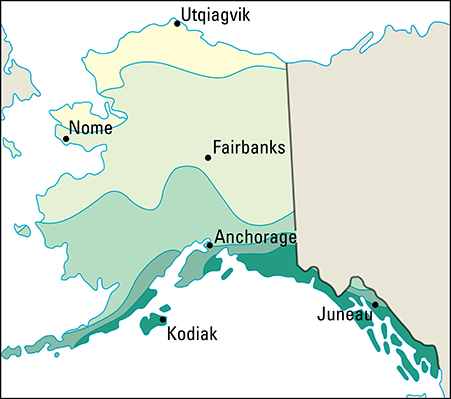
In the inland parts of Alaska, temperatures average about –7 °F (–22 °C) in January and about 61 °F (16 °C) in July. The annual precipitation averages about 15 inches (38 centimeters). Fort Yukon recorded Alaska’s highest temperature, 100 °F (38 °C), on June 27, 1915. The record low, –80 °F (–62 °C), was set at Prospect Creek, near Stevens Village, on Jan. 23, 1971. This temperature ranks as the lowest ever recorded in the United States. 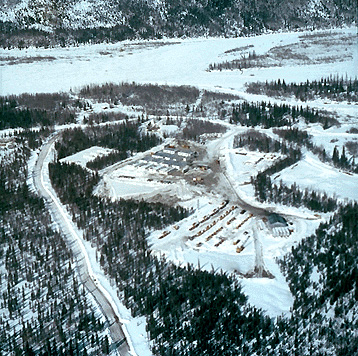
The Alaskan Arctic has an average January temperature of –13 °F (–25 °C). Its average July temperature is 44 °F (7 °C). Annual precipitation is low.
Economy
Alaska’s economy relies heavily on government activities and petroleum production. The huge amounts of petroleum produced by Alaska’s mining industry are shipped to other states in oil tankers and through the Trans-Alaska Pipeline. Although mining remains one of Alaska’s most important economic activities, other industries have helped diversify the state’s economy.

Service industries, which include such activities as government operations and transportation, are also important to the state. Tourism benefits many businesses in Alaska, including hotels, shops, restaurants, and tour organizers.
Fishing is the dominant economic activity in many parts of the state. Alaska catches more fish than any other state.
Land use is a difficult problem in Alaska because economic development and environmental protection interests often clash. The federal government owns and controls most of the state’s land, and it has set aside large areas for wildlife conservation and national parklands.
Natural resources
of Alaska include rich soils, valuable minerals, and plentiful water, fish, and forests.
Soil.
Most interior valley soils in Alaska are composed of loess (coarse particles of dust deposited by the wind). These soils resemble the soils found in the western United States, China, and other highly productive farm areas. Although Alaska’s soils are naturally productive, they need much fertilizer.
Minerals.
Oil and natural gas have been found on the Kenai Peninsula and in Cook Inlet in south-central Alaska. Large reserves of oil and natural gas lie near Prudhoe Bay on the state’s Arctic coast. Whether to tap these reserves has become a major source of debate. Some of these reserves lie beneath the Arctic National Wildlife Refuge, a protected area for birds, caribou, bears, and other creatures. Natural gas also has been found near Point Barrow in the Arctic Coastal Plain. Coal is found in the Kenai Peninsula, the Matanuska Valley, the Arctic Coastal Plain, and along the Yukon River.
Much of Alaska’s gold is found in streambeds in the Yukon River Basin near Fairbanks and the Seward Peninsula near Nome. Gold also is found in combination with other precious metals in underground deposits on many islands in southeastern Alaska.
A major zinc deposit lies northwest of Kotzebue. One of the largest molybdenum deposits in the world is near Ketchikan. Widespread deposits of sand and gravel are a valuable resource for the construction industry. In addition, Alaska has deposits of chromite, copper, gemstones, granite, limestone, nickel, platinum, silver, and tungsten.
Service industries,
taken together, account for the largest portion of Alaska’s _gross domestic product—_the total value of goods and services produced in the state in a year. Most of the service industries are concentrated in the urban areas of the state.
Anchorage is Alaska’s chief financial center. Many hotels, restaurants, and retail trade establishments operate in the Anchorage and Fairbanks areas. Government services are also important. An extensive network of government services is necessary because Alaska’s people are spread over a large area. State government activities are concentrated in Anchorage and Juneau. Military bases are near Anchorage and Fairbanks.
Transportation is essential to Alaska’s economy because the state lies far from major markets. Pipeline and shipping companies transport petroleum to processors. Ships also bring essential goods to Alaska from other states. Alaska’s location between Asia and the continental United States has also helped make it an air freight transfer hub for such companies as FedEx and United Parcel Service. At Kodiak Island, the Alaska Aerospace Development Corporation (now Alaska Aerospace Corporation) created the nation’s first privately operated rocket launch complex.
Mining.
Petroleum provides most of Alaska’s mining income. The Prudhoe Bay area is one of the world’s major petroleum-producing regions. Prudhoe Bay also contains vast natural gas reserves. The Trans-Alaska Pipeline transports petroleum south from Prudhoe Bay. Petroleum is also pumped from oil fields in the Kenai Peninsula-Cook Inlet area.
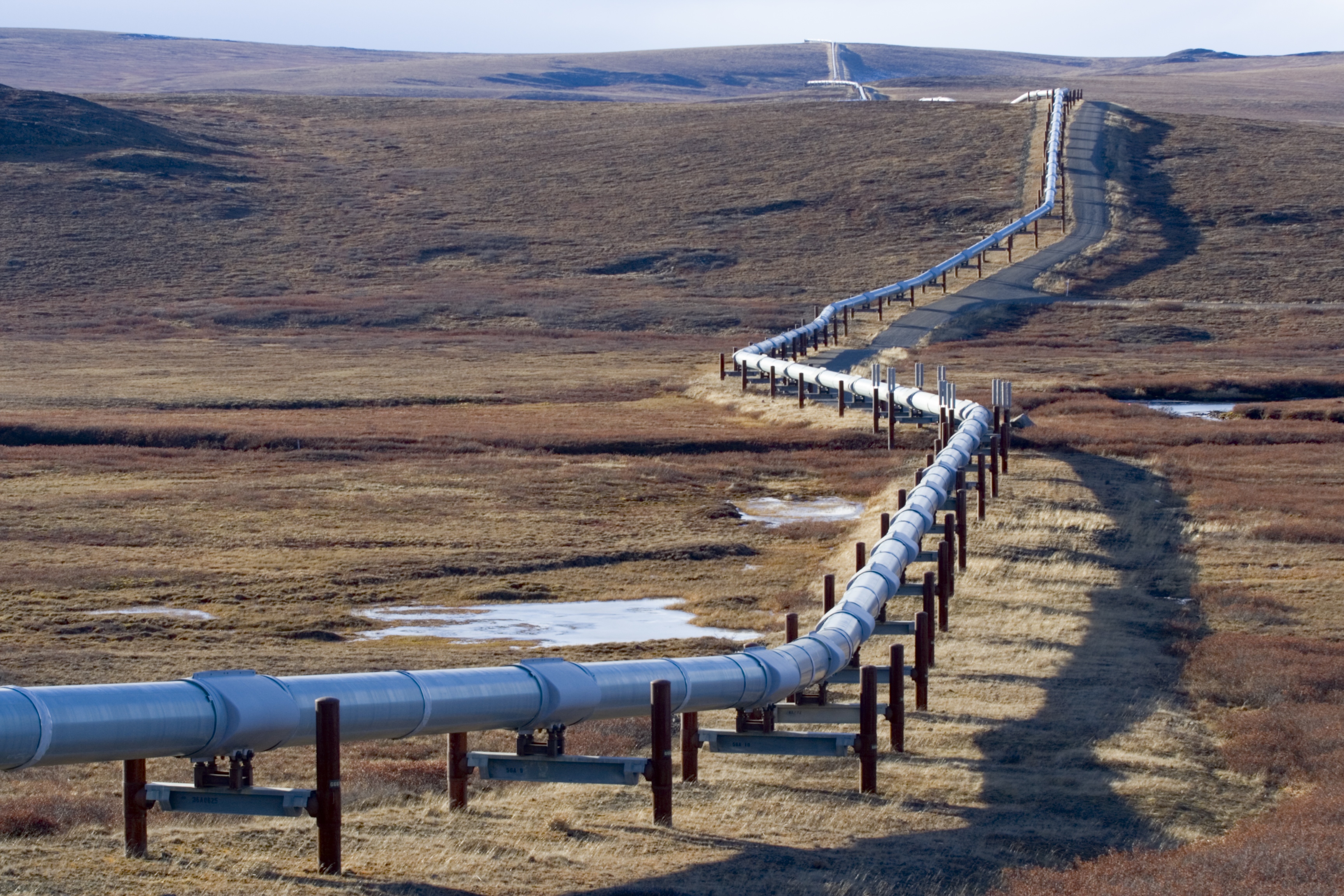
For many years, gold was Alaska’s major mined product. Today, gold is still an important mined product, and Alaska ranks as a leading gold-mining state. Much of the gold is obtained from placer deposits—particles of gold in streambeds—near Fairbanks and Nome.
Alaska is also a major producer of lead, silver, and zinc. The Red Dog Mine, near Kotzebue, is the largest zinc mine in the United States. The mine is also a leading producer of lead. The Greens Creek Mine, near Juneau, is a leading producer of both silver and zinc. Alaska’s other mined products include coal, crushed stone, and sand and gravel.
Manufacturing.
Food processing is Alaska’s leading manufacturing activity. Fish products are the main source of food-processing income. Many coastal cities process salmon and other fish. Petroleum products are also important. The Fairbanks and Kenai areas have large oil refineries. Refineries also operate at Prudhoe Bay.
Fishing industry.
Alaska leads the states in the value of fish caught by the commercial fishing industry. The state has a yearly fish catch valued at over $2 billion. Alaska is the leading catcher of cod, crabs, halibut, pollock, rockfish, sablefish, salmon, and sole. Kodiak and Unalaska/Dutch Harbor are the chief fishing ports. 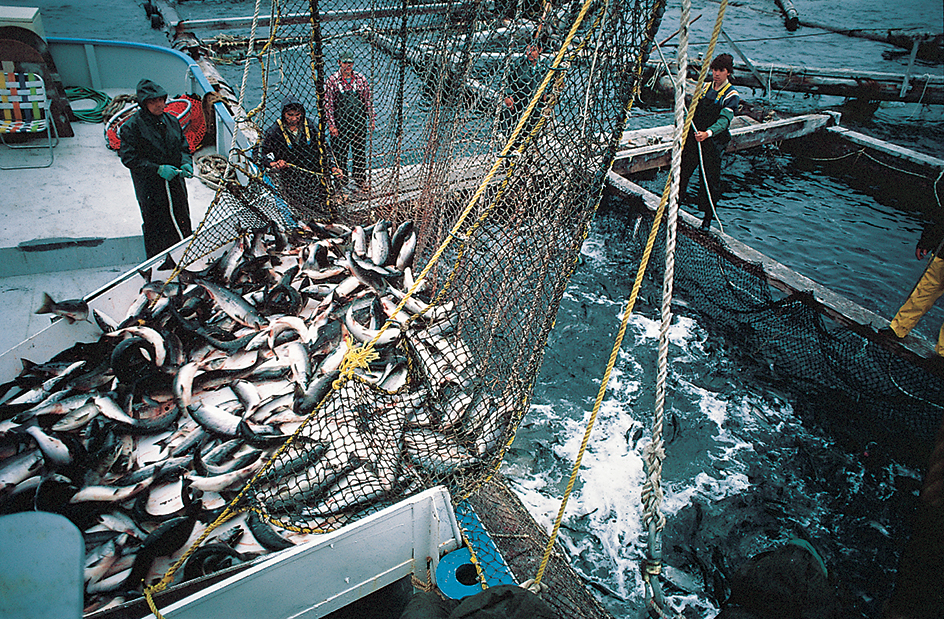
Forestry
is an important component of Alaska’s economy. Alaska has millions of acres of commercial forestland. The southern Panhandle has many log-processing camps and sawmills.
Agriculture.
Farms cover well under 1 percent of the state’s land area. The fertile Matanuska Valley northeast of Anchorage produces much of Alaska’s farm products.
Beef and milk are Alaska’s most valuable livestock products. Farmers also raise hogs and sheep. Inuit keep herds of reindeer as a source of meat and hides.
The growing season in Alaska is short. However, the summer sun shines about 20 hours a day in the central part of the state, and crops ripen quickly there. All fruits and vegetables that grow in a cool climate can be raised in Alaska as far north as the Arctic Circle. Greenhouse and nursery products are the leading source of agricultural income in Alaska. In addition, Alaskan farmers grow such crops as barley, hay, oats, and potatoes.
Fur industry.
Alaska trappers catch many kinds of fur-bearing animals, including beavers, lynxes, martens, minks, wolves, and wolverines.
Many Alaskans, most of them Inuit or Native Americans, hunt and fish for food. They also use animal skins in making clothing and other items for daily living.
Electric power and utilities.
Power plants that burn natural gas provide about half of the electric power generated in Alaska. Coal-burning plants, petroleum-burning plants, and hydroelectric plants generate most of the rest. Only a small fraction of the state’s potential hydroelectric power has been developed.
Transportation.
It is difficult and expensive to build roads and railroads in Alaska. The land is rugged, and the construction season is short.
In 1942, the federal government built the Alaska Highway—the only major land route between Alaska, Canada, and the “lower 48.” It was opened to civilian traffic in 1948. The highway extends between Dawson Creek, British Columbia, and Delta Junction, where it joins the Richardson Highway to Fairbanks. Alaska has an extensive system of roads and highways. Most of the state’s roads link the Alaska Highway with the Kenai Peninsula, Anchorage, Valdez, and Fairbanks. 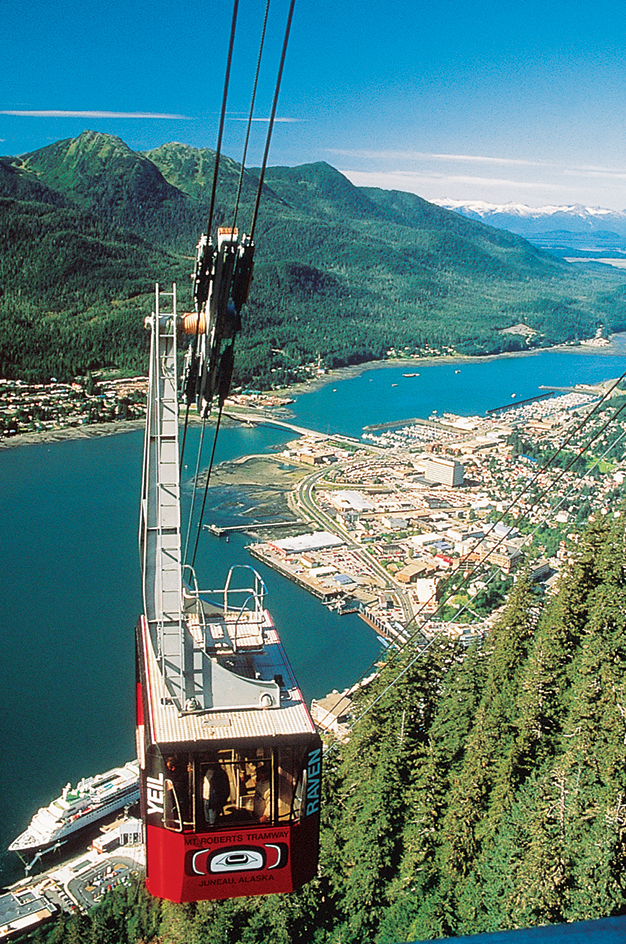
The state-owned Alaska Railroad provides freight service from Seward and Whittier to Anchorage and Fairbanks. This railroad also operates passenger trains.
Small planes flown by “bush pilots” provide the primary link between remote villages and the outside world. These pilots carry passengers, supplies, and mail across thousands of miles of rugged, remote country. Ted Stevens Anchorage International Airport is a major air terminal. It serves as one of the world’s busiest cargo hubs. Other major airports are at Juneau and Fairbanks.
Alaska depends on container ship service for most of its trade with the “lower 48.” The state’s chief ports are Anchorage, Seward, Unalaska/Dutch Harbor, Valdez, and ports near Ketchikan and Kodiak. Nome, the main port on the Bering Sea, is blocked by ice in winter.
Alaska has an outstanding ferry liner system owned by the state. Three main routes serve the state’s coastal areas. In the southeast, huge ferry liners stop at several cities between Haines and Skagway in the north and Bellingham, Washington, and Prince Rupert, British Columbia, in the south. Another route connects Cordova, Homer, Kodiak, Valdez, and Whittier. The third main route provides service between Kodiak and Unalaska/Dutch Harbor. Still another ferry route connects Juneau, Valdez, and Seward during the summer months. 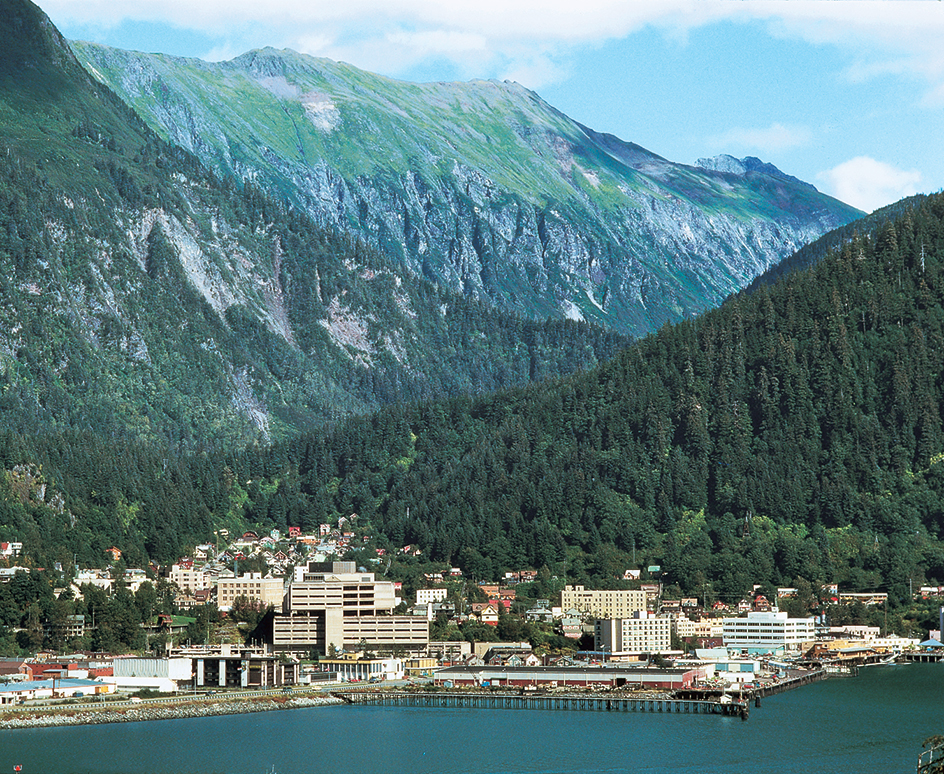
Communication.
Alaska’s first public newspaper, the Sitka Times, began publication in Sitka in 1868. Today, Alaska’s leading dailies include the Anchorage Daily News, Fairbanks Daily News-Miner, and Juneau Empire.
Government
Constitution.
Alaska’s present Constitution was adopted in 1956, three years before the territory became a state. A constitutional amendment must be approved by two-thirds of the members of each house of the state Legislature. Then it must be approved by a majority of voters in a statewide election.
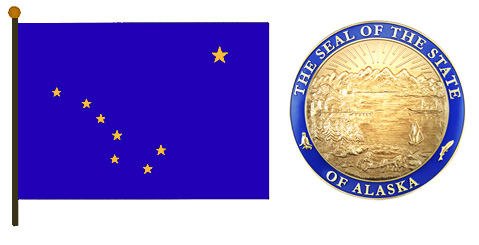
Amendments may also be proposed by a constitutional convention. The convention must be approved by a majority of each house of the Legislature. All amendments proposed by the convention must be approved by the voters. If no convention has been held in a 10-year period, the question of calling a convention must be put to the voters.
Executive.
Alaska’s governor and lieutenant governor are the state’s only elected state officials. They serve four-year terms and cannot serve more than two terms in a row.
The state’s other top executive officials include the commissioners who head 12 of Alaska’s 14 executive departments. Alaska also has an attorney general, who heads the Department of Law, and an adjutant general, who heads the Department of Military and Veterans Affairs. The governor appoints these two officials and the 12 commissioners with the approval of a majority of the legislators voting in a joint session.
Legislature
consists of a 20-member Senate and a 40-member House of Representatives. Each senatorial district elects one senator. Two representative districts make up each senatorial district. Each representative district elects one representative. Senators serve four-year terms. Representatives serve two-year terms. 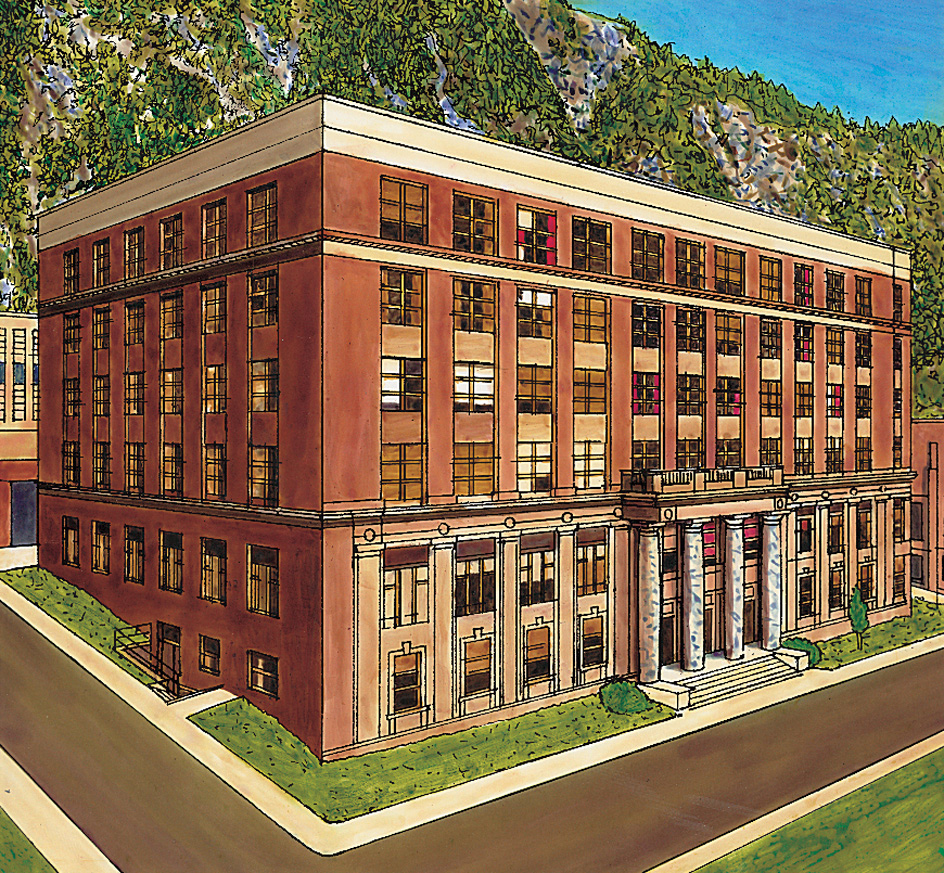
The Legislature holds a regular session every year. The sessions usually begin on the third Tuesday in January. The length of a session is limited to 90 days from the day it convenes. The Legislature or governor may call a 30-day special session.
Courts.
The highest court in the state is the Alaska Supreme Court. It has five justices, one of whom is chosen by the other justices to serve a three-year term as chief justice. The Supreme Court concentrates on civil matters but has ultimate authority in all cases.
The Court of Appeals, which has three judges, is the second-highest court for criminal matters. The Superior Court, Alaska’s second-highest court for civil cases, has 42 judges. It is divided into four districts. District courts handle civil and criminal cases. More than 20 district court judges serve in four judicial districts. The Court of Appeals has jurisdiction to review district court decisions.
The governor appoints the Supreme Court justices and the Superior Court and Court of Appeals judges from people nominated by the Alaska Judicial Council, an independent citizen’s commission that screens applicants for judicial vacancies and evaluates the performance of judges. The council consists of a chief justice and six private citizens. After serving three years, a Supreme Court justice or Superior Court or Court of Appeals judge must be approved by the voters in the next general election. Each Supreme Court justice must be reapproved every 10 years. Superior Court judges must be reapproved every 6 years, and Court of Appeals judges every 8 years.
The governor appoints district court judges from candidates recommended by the Alaska Judicial Council. Voters must approve such judges in the first general election held more than two years after their appointment, and every four years thereafter.
Local government.
Alaska is divided into 19 local government units called organized boroughs. Organized boroughs are incorporated areas that may include cities, suburbs, and rural areas. They are equivalent to counties in other states. Some boroughs are called municipalities. Each borough is governed by an assembly of from 5 to 11 members. In most boroughs, the top administrative officer is a mayor elected by the people. A borough may instead have a manager appointed by the assembly. Other borough officials are appointed by the mayor or the manager. Organized boroughs cover less than half of Alaska. However, they have about 90 percent of the population. The rest of the state is called the unorganized borough. It is governed by the Legislature.
Alaska’s cities use a mayor-council or city-manager form of government. All of the cities have elected city councils.
Revenue.
Much of the income of Alaska’s government comes directly from oil and gas production. Petroleum companies pay the state production taxes and royalties, a share of their profits. In addition, the state receives revenue from taxes on corporate income, property, and tobacco. Alaska also gets money from federal grants and other U.S. government programs. The state has no personal income tax or sales tax.
Politics.
Fewer contests take place between political parties in Alaska than in most other states. Almost all of Alaska’s state and local government officials are appointed or are elected on a nonpartisan (no-party) basis. The state’s elections for governor have resulted in several victories for both Democrats and Republicans. In elections for president, Alaska’s voters have favored the Republican candidate almost every time.
History
Early days.
No one knows exactly how long human beings have lived in America. But most scientists believe that the first Americans walked across a land bridge from Asia into what is now Alaska about 15,000 years ago. In the 1700’s, when white explorers first arrived in the Alaskan region, three groups of people—Inuit, Aleuts, and other Indigenous Alaskans—were living there.
The Inuit lived in the Far North and West. From Alaska’s north coast to Greenland, Inuit hunted such large sea mammals as whales, seals, and polar bears. Some small groups of Inuit inhabited inland areas and hunted caribou.
The Aleuts, closely related to the Inuit, lived on the Aleutian Islands and the Alaska Peninsula. The Aleuts were skillful sea hunters.
The largest Indigenous American groups, the Tlingit and Haida, were not related to the Aleuts or the Inuit. They lived along the coast, where fish and game were plentiful. Some Tsimshian people also lived there. The Athabascan peoples lived in the interior, a rugged region without the rich natural resources of the coast. The Athabascans fished and hunted caribou.
European exploration.
The Russians were the first Europeans to become interested in the Alaskan region. In 1648, a group of Russians, led by Semen I. Dezhnev, sailed through the strait separating northeastern Asia and northwestern North America. In 1725, Czar Peter the Great of Russia commissioned Vitus Bering, a Danish navigator, to explore the North Pacific region. Bering and his crew traveled more than 6,000 miles (9,700 kilometers) across Russia and Asia. Then they built a ship and in 1728 sailed through the strait navigated earlier by Dezhnev. This body of water later became known as the Bering Strait. But Bering did not sight the North American mainland because of fog. 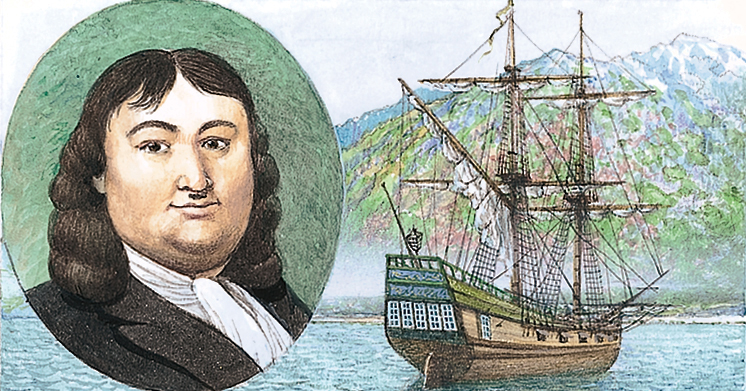
In 1741, Bering and Aleksei Chirikov, a Russian explorer, led a second expedition to the region. Bering’s party sighted Mount St. Elias in southeastern Alaska and landed on what is now Kayak Island.
Expeditions from England, France, and Spain soon reached Alaskan waters. Most of these explorers sought a sea route between the Atlantic and Pacific oceans.
The Russian era.
Members of the second Bering expedition returned to Russia with sea otter furs. Russian traders and hunters then developed a brisk fur trade on the Aleutian Islands and later on the mainland. Fur traders enslaved the Aleuts and, by overhunting, nearly destroyed populations of fur-bearing animals in the Aleutians. In 1784, Gregory Shelikof, a trader, established the first white settlement in Alaska, then called Russian America, on Kodiak Island.
In 1799, Russia chartered the Russian-American Company, a trading firm. Alexander Baranof became the firm’s chief manager. Baranof moved the company’s headquarters to Novo Arkhangelsk (New Archangel, now Sitka), which he captured from the Tlingit people. Novo Arkhangelsk became the largest town in Russian America. Baranof managed company affairs profitably for the stockholders, and he established good relations with many Indigenous groups. The Russian-American Company sent Russian Orthodox priests to convert the native Alaskans to Christianity. 
In 1818, Baranof retired, and the company began to lose money. Russian naval commanders then ruled the colony.
In 1824 and 1825, Russia signed separate treaties with the United States and the United Kingdom. These pacts recognized latitude 54° 40′ as the southern boundary of Russian territory in America. As part of the agreements, Russia gave the United States and the United Kingdom trading rights along Alaska’s Pacific Coast.
American purchase.
The Russians tried to develop several industries, including coal mining, shipbuilding, and whale hunting. But by the 1850’s, the fur trade had declined and the company’s other enterprises had begun to fail. After the Crimean War (1853-1856) weakened Russia, the country became eager to sell Alaska. United States Secretary of State William H. Seward agreed to buy the region for $7,200,000, about 2 cents per acre (5 cents per hectare). On March 30, 1867, he signed the Treaty of Cession of Russian America to the United States. Some Americans opposed the purchase. They called Alaska such names as Seward’s Folly, Seward’s Icebox, and Icebergia. But many Americans favored the acquisition. Congress approved the purchase, and American troops raised the U.S. flag at Sitka on Oct. 18, 1867. 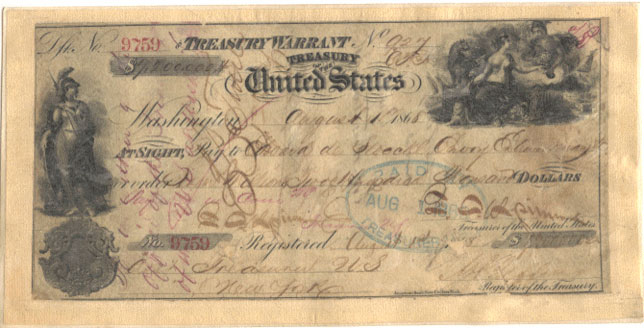
Congress did not provide for an Alaskan government during the next 17 years. Alaska was administered first by the War Department, next by the Treasury Department, and then by the Navy Department. These three agencies had little interest in the local problems of the region.
A few American companies became interested in Alaska’s rich salmon fisheries. In 1878, they built the first canneries in Alaska.
In 1884, Congress passed the first Organic Act. This act established Alaska as a “civil and judicial district.” It provided for a governor, a code of laws, and a federal court. But the laws were the laws of Oregon, and they were not adapted to Alaskan conditions. Congress kept the power to make laws for Alaska.
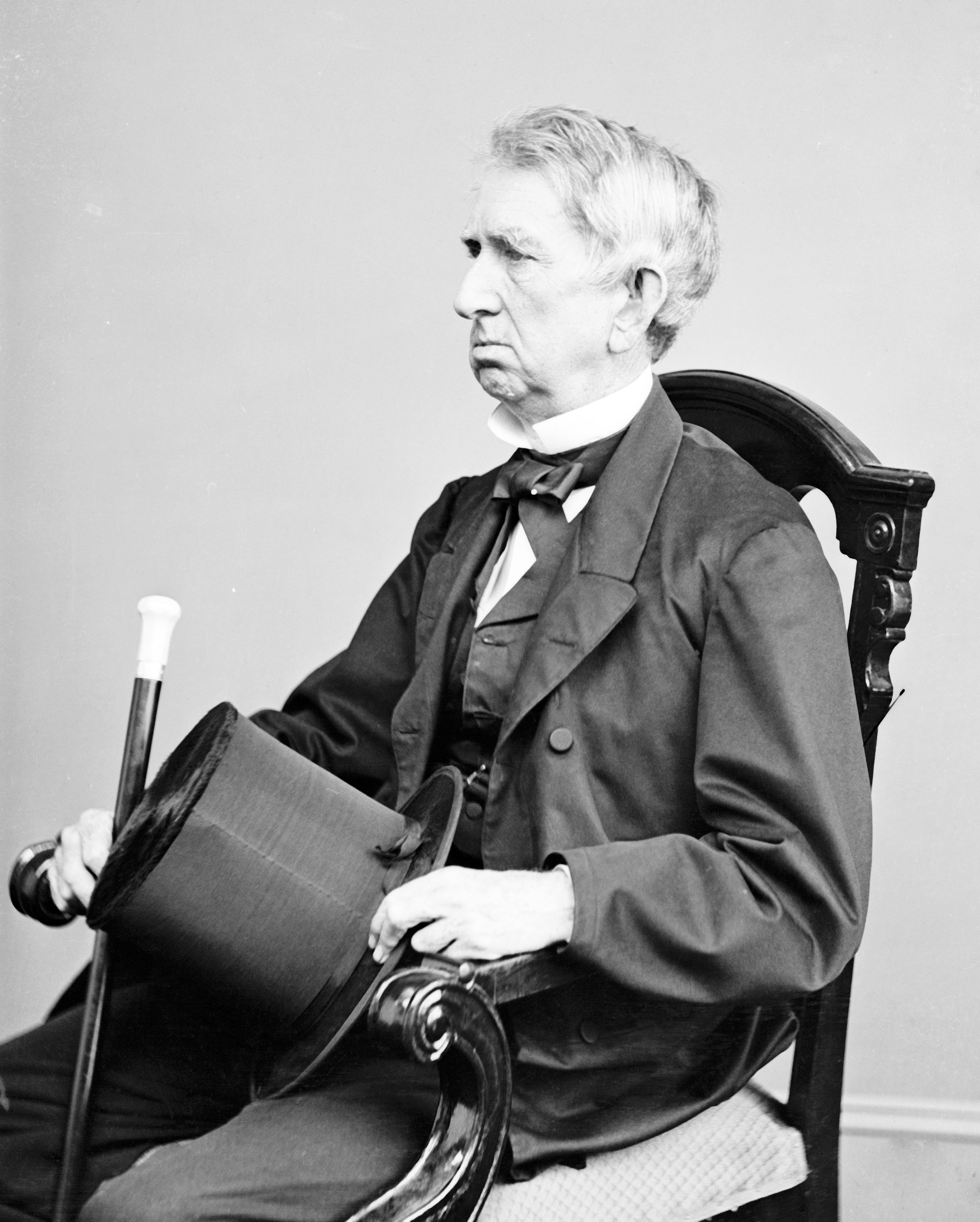
The gold rush.
In 1880, Joseph Juneau and Richard T. Harris discovered gold deposits along Gastineau Channel in southeastern Alaska. This discovery led to the founding of the city of Juneau. In 1896, prospectors found rich gold deposits in the Klondike district of Canada’s Yukon region, just across the border from Alaska. The discovery led to the Klondike and Alaska gold rush of 1897-1898. Miners discovered gold at what is now Nome in 1898 and in the Fairbanks area in 1902. The three gold discoveries attracted thousands of people hoping to strike it rich and aroused nationwide interest in Alaska. Alaska’s population nearly doubled in 10 years, reaching 63,592 by 1900. 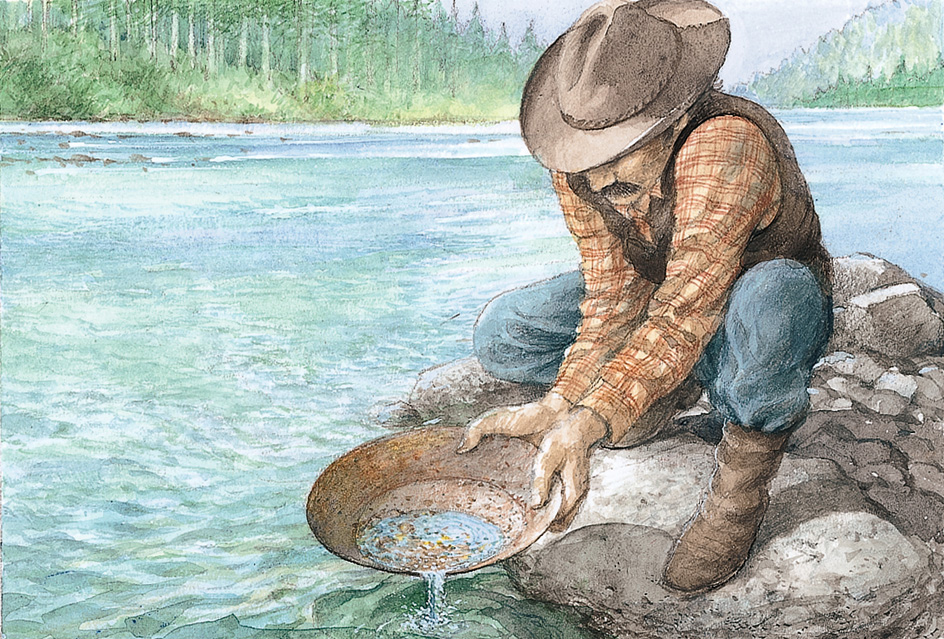
The early 1900’s.
The gold discoveries focused congressional attention on Alaska. In 1903, a group of U.S. senators toured the territory to learn of Alaska’s needs. They recommended that the government construct a system of transportation routes there. Congress then created a Board of Road Commissioners for Alaska, which built and maintained wagon roads, trails, bridges, and ferries throughout the territory. 
In 1906, Congress allowed Alaskans to elect their own delegate to Congress. They chose Frank H. Waskey, a Democrat. He could speak in the House of Representatives but was not allowed to vote. During this period, James W. Wickersham, a federal judge, rallied Alaskans to the cause of more self-government for Alaska. In 1908, Wickersham was elected Alaska’s delegate to Congress. In 1912, Congress passed the second Organic Act, which gave Alaska a territorial legislature with limited powers.
The Alaska Native Brotherhood (ANB) was formed in 1913. It was joined by the Alaska Native Sisterhood two years later. These organizations sought to unite the native communities of the region and fought for the political interests of its members. The groups helped achieve voting rights, integrated classrooms, and other civil rights for Alaska’s Indigenous peoples.
In 1929, the ANB enlisted Wickersham to pursue a settlement for native lands seized by the federal government. Wickersham failed to persuade Congress to recognize native land claims. But the work of his successors and native groups eventually led to the Alaska Native Claims Settlement Act of 1971.
World War II
(1939-1945) caused great changes in Alaska. The United States recognized the military importance of the territory, which lay close to Asia, and sent thousands of workers there to build and maintain military installations. In 1942, the Japanese bombed Dutch Harbor in the Aleutian Islands and occupied Kiska and Attu, two islands in the chain. These islands were the only part of North America invaded during World War II. The government built the Alaska Highway in 1942, mainly as a military supply road. In 1943, about 152,000 military personnel were stationed in Alaska. United States troops recovered Kiska and Attu later that year, and the war in Alaska ended. But the military impact altered the territory forever.
Statehood.
The war led to demands that Congress admit the territory to statehood. The first Alaskan statehood bill was introduced in Congress in 1916, but it did not receive a hearing. Other statehood bills were introduced from the mid-1940’s until 1958. In 1958, Congress voted to admit Alaska to the Union. On Jan. 3, 1959, President Dwight D. Eisenhower signed the proclamation declaring Alaska the 49th state. Alaska became the first new state since 1912. William A. Egan, a Democrat, became the first elected governor of Alaska. 
Alaska found its first years of statehood difficult and costly. It had to take over the expenses of public services that the federal government had provided. Congress helped by giving Alaska some buildings, transition grants, and other funding. Alaska also received funds from the lease of public lands and the right to claim 103.5 million acres (41.9 million hectares) of federal land over a 25-year period. State selection of lands began soon afterward. Alaska’s Inuit and Indigenous American groups, however, protested the selection process. They charged that the process did not recognize their claims of ownership or their traditional way of life, in which small bands moved over large areas hunting, fishing, and gathering food. These and other issues spurred the formation of the Alaska Federation of Natives (AFN) in 1966. The organization included representatives from nearly every group of native people and helped lead the fight for a full settlement of Alaska native land claims.
During the 1960’s, the state improved its transportation facilities. It developed a state ferry system, the “Marine Highway,” to serve coastal cities.
In 1964, one of the biggest earthquakes ever known to hit North America shook the area around Anchorage and Valdez. It measured 9.2 on the moment magnitude scale. The quake and the tsunami (series of huge, destructive ocean waves) that it caused killed 131 people and resulted in more than $300 million in property damage.
The discovery of oil.
In 1968, the Atlantic Richfield Company announced the discovery of a giant oil field at Prudhoe Bay on the Arctic Coastal Plain. It was one of the greatest oil discoveries in history. This oil field has the largest reserves of oil in North America. In 1969, Alaska auctioned oil and gas leases on the field’s 450,000 acres (182,000 hectares) and earned over $900 million. Construction of a pipeline to carry oil about 800 miles (1,300 kilometers) across the state, from Prudhoe Bay to the port of Valdez, began in 1974. The pipeline was completed in 1977 at a total cost of about $8 billion, and oil production began.
The development of the Prudhoe Bay oil field provided new jobs and greatly increased state revenues during the late 1970’s and early 1980’s. In 1976, Alaska’s voters had approved an amendment to the state Constitution that created the Alaska Permanent Fund, a savings account that belongs to all the people of Alaska. The amendment calls for at least 25 percent of all money earned by mineral development to be deposited into this fund. In 1980, the high revenues created by the oil boom enabled the state government to abolish individual state income taxes. In 1982, every Alaskan resident of six months or more began receiving dividend payments from the Alaska Permanent Fund.
Land-use issues.
From 1971 to 1980, the federal government set aside large amounts of land for native Alaskans and for conservation purposes. In 1971, President Richard M. Nixon signed the Alaska Native Claims Settlement Act. This revolutionary measure gave $962.5 million and about 44 million acres (18 million hectares) of land to the state’s Inuit and Indigenous Americans. The act created 12 regional corporations to administer the money and the land. A 13th corporation was added later. Every Alaskan Inuit and Indigenous American received shares in the corporations.
In 1978, 56 million acres (23 million hectares) of Alaskan land were set aside as national monuments. In 1980, Congress passed the Alaska National Interest Lands Conservation Act. This act added more than 104 million acres (42 million hectares) to the conservation system in Alaska. The measure established the boundaries of a widespread network of federal, state, native, and private lands.
The 1980 conservation act gave rural Alaskans priority in hunting and fishing for food on federal lands. Many urban Alaskans who hunt and fish for sport complained that these provisions discriminated against them. Disputes over hunting and fishing rights led to increasing tensions between urban whites and rural Indigenous peoples. By the 1990’s, Alaskans still had not complied with the provisions of the act. As a result, the federal government took over fish and game management on the federal lands.
Recent developments.
In 1989, an oil tanker, the Exxon Valdez, struck a reef in Prince William Sound in southeastern Alaska, causing one of the largest oil spills in United States history. Nearly 11 million gallons (42 million liters) of crude oil spilled into the sound. The oil polluted beaches and fishing waters and destroyed wildlife. Most of the cleanup work at the sound was completed in 1992 at a cost of more than $2 billion. But scientists continued to work toward restoring the ecological balance of the area.
In 1998, the Alaska SeaLife Center opened in Seward, Alaska. The center includes educational exhibits as well as facilities for research and the care of sick and injured animals. Much of the center’s construction was funded by money from a settlement in the Exxon Valdez case.
In 2006, Sarah Palin became the first woman elected governor of Alaska. Palin became the Republican nominee for U.S. vice president in 2008. She resigned as governor in 2009.
Fluctuations in oil prices have led to periodic state budget deficits and surpluses in Alaska. Falling crude oil prices led to a state budget crisis beginning in 2015. Alaska lawmakers considered cuts in government positions and other measures to trim the state’s deficit. In 2018, legislators moved to reduce the budget deficit by passing a law allowing the state to access billions of dollars from the Alaska Permanent Fund. In 2022, soaring oil prices contributed to a budget surplus for the state.
